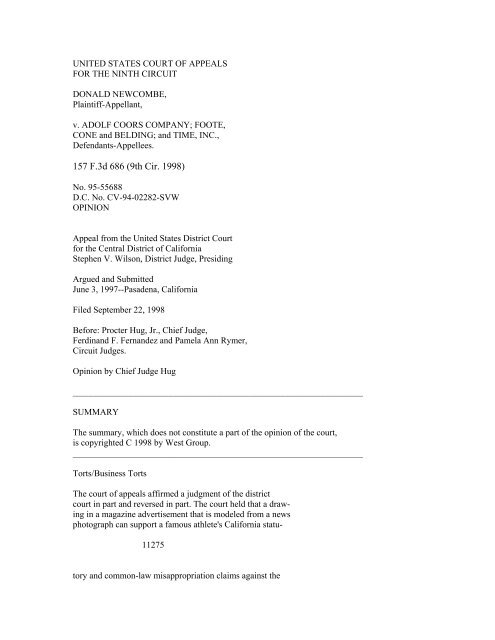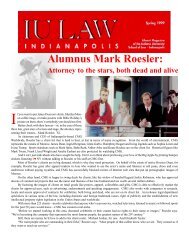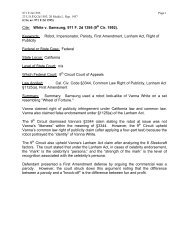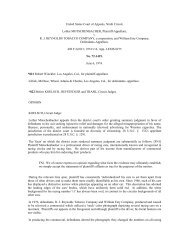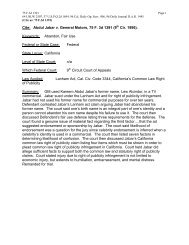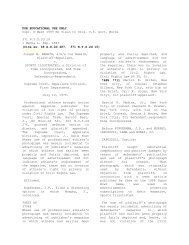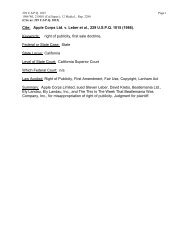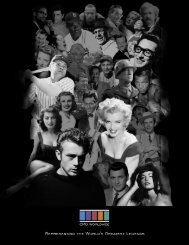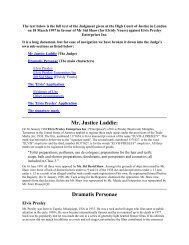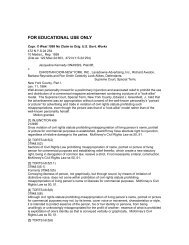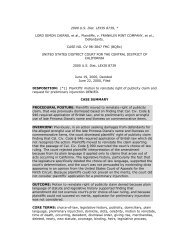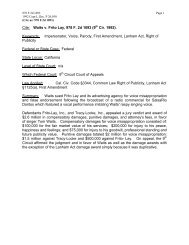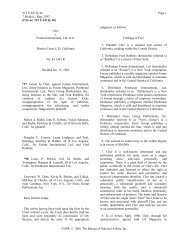Newcombe v. Adolf Coors Co. _1998_.pdf - Mark Roesler
Newcombe v. Adolf Coors Co. _1998_.pdf - Mark Roesler
Newcombe v. Adolf Coors Co. _1998_.pdf - Mark Roesler
Create successful ePaper yourself
Turn your PDF publications into a flip-book with our unique Google optimized e-Paper software.
UNITED STATES COURT OF APPEALS<br />
FOR THE NINTH CIRCUIT<br />
DONALD NEWCOMBE,<br />
Plaintiff-Appellant,<br />
v. ADOLF COORS COMPANY; FOOTE,<br />
CONE and BELDING; and TIME, INC.,<br />
Defendants-Appellees.<br />
157 F.3d 686 (9th Cir. <strong>1998</strong>)<br />
No. 95-55688<br />
D.C. No. CV-94-02282-SVW<br />
OPINION<br />
Appeal from the United States District <strong>Co</strong>urt<br />
for the Central District of California<br />
Stephen V. Wilson, District Judge, Presiding<br />
Argued and Submitted<br />
June 3, 1997--Pasadena, California<br />
Filed September 22, <strong>1998</strong><br />
Before: Procter Hug, Jr., Chief Judge,<br />
Ferdinand F. Fernandez and Pamela Ann Rymer,<br />
Circuit Judges.<br />
Opinion by Chief Judge Hug<br />
_________________________________________________________________<br />
SUMMARY<br />
The summary, which does not constitute a part of the opinion of the court,<br />
is copyrighted C <strong>1998</strong> by West Group.<br />
_________________________________________________________________<br />
Torts/Business Torts<br />
The court of appeals affirmed a judgment of the district<br />
court in part and reversed in part. The court held that a drawing<br />
in a magazine advertisement that is modeled from a news<br />
photograph can support a famous athlete's California statu-<br />
11275<br />
tory and common-law misappropriation claims against the
advertiser and the advertising agency.<br />
Appellant Don <strong>Newcombe</strong> is a former major league baseball<br />
star and a recovering alcoholic. He has used his fame to<br />
advocate the dangers of alcohol.<br />
In Sports Illustrated, a national sports magazine, Killian's<br />
Irish Red Beer published an advertisement featuring a drawing<br />
of an old-time baseball game. <strong>Newcombe</strong>, his family,<br />
friends, and former teammates recognized the pitcher in the<br />
drawing as <strong>Newcombe</strong>.<br />
<strong>Newcombe</strong> sued appellees Adolph <strong><strong>Co</strong>ors</strong> <strong>Co</strong>mpany, Foote,<br />
<strong>Co</strong>ne and Belding, its advertising firm, and Time, Inc., the<br />
publisher of Sports Illustrated, in California state court. The<br />
complaint alleged that <strong>Newcombe</strong>'s identity had been misappropriated<br />
in violation of state statutory and common law;<br />
that the ad was defamatory because it portrayed him as<br />
endorsing beer; that the ad was negligently created; and that<br />
the defendants intentionally inflicted emotional distress on<br />
him. <strong>Newcombe</strong> sought an injunction against future publication<br />
of the advertisement, $100 million in damages, and imposition<br />
of a constructive trust. The defendants removed the<br />
action to federal court based on diversity.<br />
<strong><strong>Co</strong>ors</strong> admitted that the drawing in the ad was based on a<br />
newspaper photo of <strong>Newcombe</strong> pitching in the 1949 World<br />
Series; the drawing and the photo were virtually identical. The<br />
pitcher's uniform number had been changed, and the color of<br />
the bill of his hat was different in the two images.<br />
<strong>Newcombe</strong> had asked the defendants to disclose the identity<br />
of the artist who drew the scene portrayed in the ad so that<br />
the artist could be named as a defendant, but they honored the<br />
artist's request to keep his name confidential. During discovery,<br />
they divulged his name and location: Michael Cassidy of<br />
Del Mar, California.<br />
11276<br />
<strong>Newcombe</strong> moved to remand the action on the ground that<br />
because both he and Cassidy were California residents, diversity<br />
was destroyed.<br />
The district court denied the remand motion, concluding<br />
that Cassidy did not have to be joined because he was neither<br />
a necessary nor indispensable party. The court went on to<br />
grant summary judgment for the defendants on all claims.<br />
<strong>Newcombe</strong> appealed.
[1] The district court was correct in considering only the<br />
domicile of the named defendants. The defendants were under<br />
no obligation to disclose the artist's identity prior to discovery.<br />
The defendants therefore did not improperly conceal Cassidy's<br />
identity. There was no indication that <strong>Newcombe</strong><br />
attempted to ascertain the identity of the artist prior to filing<br />
the lawsuit, and if he did, there was no indication that the<br />
defendants attempted to thwart his efforts. <strong>Newcombe</strong> filed<br />
the suit knowing that removal was a real possibility. <strong>Newcombe</strong><br />
could have foreclosed removal by delaying until he<br />
could add a non-diverse defendant; he chose not to do so.<br />
Because the defendants did not act improperly and the statutory<br />
requirements for removal were met, removal was proper.<br />
[2] Once removal has occurred, the district court has two<br />
options in dealing with an attempt to join a non-diverse party.<br />
The court may deny joinder, or permit joinder and remand the<br />
action to state court. The court has discretion to deny joinder.<br />
[3] The district court considered the potential prejudice,<br />
balanced the equities, and determined that no injustice would<br />
occur. The court concluded that Cassidy was not a crucial<br />
defendant, and that <strong>Newcombe</strong> would not suffer prejudice due<br />
to Cassidy's absence because he could subpoena him, and<br />
proceed against Cassidy in state court if he chose. The district<br />
court did not abuse its discretion.<br />
[4] California has long recognized a common-law right of<br />
privacy for the protection of a person's name and likeness<br />
11277<br />
against appropriation by others for their advantage. This cause<br />
of action has been complemented by Cal. Civ. <strong>Co</strong>deS 3344,<br />
which provides that the statutory remedies are cumulative and<br />
in addition to any others provided by law.<br />
[5] To sustain a common-law cause of action for commercial<br />
misappropriation, a plaintiff must prove the defendant's<br />
use of the plaintiff's identity; the appropriation of the plaintiff's<br />
name or likeness to the defendant's advantage, commercially<br />
or otherwise; lack of consent; and resulting injury. [6]<br />
Section 3344 requires a plaintiff to establish "knowing" use;<br />
for purposes of advertising; and a direct connection between<br />
the use and the commercial purpose.<br />
[7] Section 3344 states that a photograph must be "readily<br />
identifiable" as to plaintiff for the plaintiff to prevail. A person<br />
is deemed readily identifiable when one who views the<br />
photograph can reasonably determine that the person depicted
is the same person who is complaining of its unauthorized<br />
use. Because a likeness and a photograph are so similar, application<br />
of this standard is appropriate to likenesses. To constitute<br />
<strong>Newcombe</strong>'s likeness, the pitcher in the advertisement<br />
had to be readily identifiable as <strong>Newcombe</strong>.<br />
[8] A triable issue of fact was raised as to whether <strong>Newcombe</strong><br />
was readily identifiable as the pitcher in the advertisement.<br />
The drawing and the photograph were virtually identical.<br />
[9] In addition to the identifiability of the pitcher in the<br />
advertisement as <strong>Newcombe</strong> based on the pitcher's stance, the<br />
pitcher's skin was moderately dark, which was quite similar<br />
to <strong>Newcombe</strong>'s skin color. A jury could rationally have found<br />
that <strong>Newcombe</strong> was readily identifiable, even though his<br />
facial features were not entirely visible.<br />
[10] While the drawing was slightly altered from the photograph,<br />
that did not alter the conclusion that there was a genuine<br />
issue of material fact as to whether the advertisement<br />
made use of <strong>Newcombe</strong>'s likeness. It was not persuasive that<br />
11278<br />
the coloring of the bill of the hat in the advertisement was different,<br />
in light of the fact that the rest of the uniform was<br />
identical to the uniform in the photograph.<br />
[11] <strong>Newcombe</strong>'s likeness was used to <strong><strong>Co</strong>ors</strong>' and to<br />
Belding's commercial advantage, as the drawing was a central<br />
figure in the advertisement and the purpose of the advertisement<br />
was to attract attention. However, the use of <strong>Newcombe</strong>'s<br />
likeness could not be said to have directly benefited<br />
Time, because the payment it received for the advertising<br />
space was unrelated to the content of the advertisement. Summary<br />
judgment was therefore appropriate as to Time. [12]<br />
<strong>Newcombe</strong> did not consent to the use of his likeness, and he<br />
was injured because he was not compensated for the use.<br />
Summary judgment was improper as to <strong><strong>Co</strong>ors</strong> and Belding on<br />
<strong>Newcombe</strong>'s common-law misappropriation claim.<br />
[13] Section 3344 states that not all uses of likenesses are<br />
a "use" that requires consent; only uses where the likeness is<br />
directly connected with the commercial sponsorship constitutes<br />
a "use" under S 3344. Whether such a connection is<br />
present is a question of fact. It would not have been unreasonable<br />
for a jury to conclude that there was a direct connection<br />
between <strong>Newcombe</strong> and the commercial sponsorship of Killian's<br />
Red.<br />
[14] Section 3344 exempts from liability owners of any
advertising medium by whom any advertisement in violation<br />
of the section is published, unless such owners had knowledge<br />
of the unauthorized use. This exemption absolved Time, as<br />
<strong>Newcombe</strong> failed to allege that Time knew that <strong>Newcombe</strong><br />
had not authorized the use of his likeness. Summary judgment<br />
on <strong>Newcombe</strong>'s statutory claim was therefore appropriate as<br />
to Time.<br />
[15] <strong>Newcombe</strong> was entitled to proceed to trial on his<br />
common-law claim against <strong><strong>Co</strong>ors</strong> and Belding, and on his<br />
claim for equitable relief and constructive trust against them.<br />
11279<br />
[16] California courts have determined that a false light<br />
claim that rests on the false nature of the publication is substantively<br />
equivalent to a libel claim based on the same publication.<br />
[17] Under Cal. Civ. <strong>Co</strong>deS 45a, a plaintiff may<br />
prevail on a libel claim only if the publication is libelous on<br />
its face, or special damages have been proven. A publication<br />
is libelous on its face only if there is no need for explanatory<br />
matter. <strong>Newcombe</strong> did not meet either requirement. <strong>Newcombe</strong><br />
presented no evidence that an average person viewing<br />
the advertisement would think that it was defamatory to suggest<br />
that the pitcher was endorsing alcohol. The only way an<br />
average person might think that it was defamatory was if the<br />
person was made aware of <strong>Newcombe</strong>'s status as a recovering<br />
alcoholic. This was textbook explanatory matter.<br />
[18] <strong>Newcombe</strong> also failed to meet the requirement that<br />
special damages must be pled when the defamatory language<br />
is not libelous on its face. None of the expenses he incurred<br />
constituted special damages because they did not relate to<br />
<strong>Newcombe</strong>'s property, business, trade, profession, or occupation.<br />
[19] <strong>Newcombe</strong>'s negligence claim was a claim for negligent<br />
publication, i.e., the defendants were negligent because<br />
they published the advertisement before adequately investigating<br />
how it was prepared. A claim for negligent publication<br />
is essentially the same as either a claim for misappropriation<br />
or for defamation, and the constitutional and statutory principles<br />
regarding those standards cannot be circumvented by artful<br />
pleading.<br />
[20] To prevail on a claim of intentional infliction of emotional<br />
distress, the plaintiff must prove that the defendants'<br />
conduct was outrageous; the defendants intended to cause, or<br />
recklessly disregarded the likelihood of causing, emotional<br />
distress; the plaintiff experienced severe emotional suffering;
and actual and proximate cause of emotional distress.<br />
11280<br />
[21] There was no evidence that the defendants engaged in<br />
conduct that was intentionally outrageous. Even if the pitcher<br />
portrayed in the advertisement was virtually identical to the<br />
photograph that Cassidy used as a model, Cassidy declared<br />
that he did not know who <strong>Newcombe</strong> was, or that <strong>Newcombe</strong><br />
was a recovering alcoholic. It could not be said that Cassidy<br />
copied the photograph with an intent to harm <strong>Newcombe</strong>.<br />
There was no evidence that anyone else associated with the<br />
production of the advertisement intended that it portray <strong>Newcombe</strong>,<br />
or that they were aware that the drawing closely<br />
resembled him. An intent to inflict emotional distress on<br />
<strong>Newcombe</strong> therefore could not be imputed to the defendants.<br />
The district court did not err in granting summary judgment<br />
on this claim.<br />
_________________________________________________________________<br />
COUNSEL<br />
Joseph J. Iacopino, Sherman Oaks, California, for the<br />
plaintiff-appellant.<br />
Henry L. Mason, III, Sidley & Austin, Chicago, Illinois, for<br />
the defendants-appellees.<br />
_________________________________________________________________<br />
OPINION<br />
HUG, Chief Judge:<br />
Donald <strong>Newcombe</strong>, a former major league baseball all-star<br />
appeals the district court's order denying his motion to<br />
remand to state court due to lack of diversity, and the grant<br />
of summary judgment in favor of the defendants on all claims<br />
of various torts arising from the publication of a beer advertisement<br />
allegedly bearing his likeness. In this diversity<br />
action, <strong>Newcombe</strong> contends that his likeness and identity<br />
were used without his permission in an advertisement for Kil-<br />
11281<br />
lian's Irish Red Beer, and that this violated California's statutory<br />
and common law protections against commercial<br />
misappropriation. <strong>Newcombe</strong> also contends that the advertise-
ment was negligently created, that the defendants intentionally<br />
inflicted emotional distress upon him and that because he<br />
is a known recovering alcoholic, using his likeness in a beer<br />
advertisement was defamatory. We have jurisdiction pursuant<br />
to 28 U.S.C. S 1291, and we affirm in part and reverse in part.<br />
FACTS AND PROCEDURAL BACKGROUND<br />
<strong>Newcombe</strong> is a former major league baseball all-star who<br />
pitched for the Brooklyn Dodgers and other teams from 1949<br />
until 1960. He had previously starred in the so-called Negro<br />
leagues and was one of the first African-American players to<br />
play in the major leagues after Jackie Robinson broke the<br />
color barrier in 1947. <strong>Newcombe</strong> is the only player in major<br />
league history to have won the Most Valuable Player Award,<br />
the Cy Young Award, and the Rookie of the Year Award. He<br />
was a four-time member of the National League All Star<br />
Team, he batted over .300 in four different seasons, and had<br />
the most wins of any pitcher in the National League in 1950,<br />
1951, 1955, and 1956.<br />
<strong>Newcombe</strong>'s baseball career was cut short due to his service<br />
in the Army and a personal battle with alcohol. He is a<br />
recovering alcoholic and he has devoted a substantial amount<br />
of time using his fame to advocate the dangers of alcohol,<br />
including serving as a spokesperson for the National Institute<br />
on Drug and Alcohol Abuse pursuant to presidential appointments<br />
by Richard Nixon, Gerald Ford and Ronald Reagan. He<br />
is currently the Director of <strong>Co</strong>mmunity Relations with the Los<br />
Angeles Dodgers, where he continues an active role in fighting<br />
alcohol abuse.<br />
Killian's Irish Red Beer, owned by <strong><strong>Co</strong>ors</strong> Brewing <strong>Co</strong>.,<br />
published an advertisement in the February 1994 Sports Illustrated<br />
"swimsuit edition" that featured a drawing of an old-<br />
11282<br />
time baseball game. The drawing was on the left half of the<br />
full-page advertisement while the right half was filled with<br />
text and a picture of a glass of beer. The baseball scene<br />
focused on a pitcher in the windup position and the background<br />
included a single infielder and an old-fashioned outfield<br />
fence. The players' uniforms did not depict an actual<br />
team, and the background did not depict an actual stadium.<br />
However, <strong>Newcombe</strong>, along with family, friends and former<br />
teammates, immediately recognized the pitcher featured in the<br />
advertisement as <strong>Newcombe</strong> in his playing days.<br />
<strong>Newcombe</strong> filed suit in California state court on March 10,
1994, alleging that his identity had been misappropriated in<br />
violation of California statutory and common law, that the<br />
advertisement was defamatory because it portrayed him -- a<br />
recovering alcoholic -- as endorsing beer, that the advertisement<br />
was negligently created, and that the defendants intentionally<br />
inflicted emotional distress upon him. He sought to<br />
enjoin the advertisement from future publication, and he<br />
asked for $100,000,000 in damages. In his complaint, <strong>Newcombe</strong><br />
named <strong><strong>Co</strong>ors</strong>, Foote <strong>Co</strong>ne & Belding Advertising<br />
("Belding") (the creator of the ad) and Time Inc. (the publisher<br />
of Sports Illustrated) as defendants ("the defendants"),<br />
and included 100 "Doe" defendants -- those who were<br />
"responsible in some manner for the events and happenings"<br />
referred to in the complaint. The defendants invoked diversity<br />
jurisdiction and removed this action to federal court on April<br />
8, 1994.<br />
While denying that the pitcher in the advertisement was a<br />
"likeness" of <strong>Newcombe</strong>, <strong><strong>Co</strong>ors</strong> admitted that the drawing in<br />
the color advertisement was based on a newspaper photograph<br />
of <strong>Newcombe</strong> pitching in the 1949 World Series. The drawing<br />
and the newspaper photograph are virtually identical, as<br />
though the black and white newspaper photo had been traced<br />
and colored in. The only major differences between the newspaper<br />
photograph of <strong>Newcombe</strong> and the drawing of him are<br />
that the pitcher's uniform number has been changed from<br />
11283<br />
"36" to "39," and the bill of the hat in the drawing is a different<br />
color from the rest of the hat. Otherwise, the drawing in<br />
the advertisement appears to be an exact replica of the newspaper<br />
photograph of <strong>Newcombe</strong>.<br />
Prior to filing this lawsuit, <strong>Newcombe</strong> allegedly made<br />
repeated requests of the defendants to divulge the identity of<br />
the artist who drew the scene portrayed in the advertisement<br />
-- the name "Cassidy" was signed at the bottom of the advertisement<br />
-- so that the artist could be named as a defendant,<br />
but the defendants honored the artist's request not to have his<br />
name disclosed and did not divulge this information. During<br />
discovery -- the first time the defendants were legally obligated<br />
to disclose information about the artist -- they informed<br />
<strong>Newcombe</strong> that the artist's full name was Michael Cassidy<br />
and that he lived in Del Mar, California.<br />
Immediately after learning that Cassidy was a resident of<br />
California, <strong>Newcombe</strong> filed a motion on August 29, 1994, to<br />
have the case remanded to state court because <strong>Newcombe</strong> is<br />
also a California resident, thus destroying diversity. The dis-
trict court denied the motion after finding that Cassidy need<br />
not be joined as a defendant because he was neither a necessary<br />
nor indispensable party under Fed. R. Civ. P. 19. Six<br />
months later, the district court granted summary judgment in<br />
favor of the defendants on all claims. <strong>Newcombe</strong> now<br />
appeals.<br />
DISCUSSION<br />
I. Remand<br />
<strong>Newcombe</strong> first argues that remand to state court is necessary<br />
because removal was improper in the first instance. We<br />
review the propriety of removal de novo because it is a question<br />
of federal subject matter jurisdiction. Kruse v. State of<br />
Hawaii, 68 F.3d 331, 333 (9th Cir. 1995).<br />
11284<br />
At the time the defendants sought to remove this action to<br />
federal court, there was complete diversity among the parties<br />
and the matter in controversy was in excess of $50,000, thus<br />
meeting the requirements for removal. See 28 U.S.C.<br />
S 1332(a); 28 U.S.C. S 1441(a).1 <strong>Newcombe</strong> contends that<br />
there was not complete diversity because the defendants were<br />
aware that he intended to add Cassidy as a defendant and that<br />
Cassidy's presence would destroy diversity. Because the<br />
defendants concealed Cassidy's identity until after they<br />
removed this action to federal court, <strong>Newcombe</strong> argues, the<br />
defendants misrepresented to the court that there was complete<br />
diversity when in fact there was not. <strong>Newcombe</strong>'s claim<br />
must fail.<br />
[1] First, 28 U.S.C. S 1441(a) explicitly provides that the<br />
citizenship of defendants sued under fictitious names shall be<br />
disregarded for purposes of removal. As such, the district<br />
court was correct in only considering the domicile of the<br />
named defendants. Second, the defendants were under no<br />
legal obligation to disclose the artist's identity prior to discovery.<br />
Therefore, we cannot agree with <strong>Newcombe</strong> that the<br />
defendants improperly concealed Cassidy's identity. Furthermore,<br />
equity does not require the result requested by <strong>Newcombe</strong>.<br />
There is no indication that <strong>Newcombe</strong> attempted to<br />
independently ascertain the identity of the artist prior to filing<br />
this lawsuit, and even if he did, there is no indication that the<br />
defendants attempted to thwart these efforts. <strong>Newcombe</strong> filed<br />
this suit knowing that there was complete diversity among the<br />
named defendants and that removal was a real possibility.<br />
<strong>Newcombe</strong> could have foreclosed the possibility of removal<br />
by delaying filing suit until he could add a non-diverse defen-
dant; he chose not to do so and instead filed suit less than a<br />
month after first viewing the ad. Because the defendants did<br />
_________________________________________________________________<br />
1 The amount in controversy requirement has subsequently been<br />
increased to $75,000. 28 U.S.C. S 1441(a) (as amended Oct. 19, 1996,<br />
Pub.L. 104-317, Title II, S 205(a), 110 Stat. 3850).<br />
11285<br />
not act improperly and because the statutory requirements for<br />
removal were met, removal was proper.<br />
<strong>Newcombe</strong> also argues that the district court should have<br />
granted his motion to remand this action to state court once<br />
Cassidy's identity and domicile were divulged because Cassidy's<br />
presence destroyed diversity of citizenship. 2 The district<br />
court denied the motion to remand after determining that<br />
under Fed. R. Civ. P. 19, Cassidy was neither a necessary nor<br />
indispensable party. For the reasons articulated below, we<br />
review for an abuse of discretion the district court's decision<br />
not to allow joinder of a party that would destroy diversity.<br />
[2] Once removal has occurred, the district court has two<br />
options in dealing with an attempt to join a non-diverse party.<br />
28 U.S.C. S 1447(e) provides that<br />
[i]f after removal the plaintiff seeks to join additional<br />
defendants whose joinder would destroy subject matter<br />
jurisdiction, the court may deny joinder, or permit<br />
joinder and remand the action to the State court.<br />
The language of S 1447(e) is couched in permissive terms and<br />
it clearly gives the district court the discretion to deny joinder.<br />
Because the decision regarding joinder of a diversity<br />
destroying-defendant is left to the discretion of the district<br />
court, we may only review the district court's decision for an<br />
abuse of discretion.<br />
[3] The district court considered the potential prejudice to<br />
<strong>Newcombe</strong>, balanced the equities, and determined that no<br />
_________________________________________________________________<br />
2 <strong>Newcombe</strong> did not move to amend his complaint to include Cassidy<br />
as a defendant prior to his motion to remand. The district court noted that<br />
the proper procedure would have been to first add Cassidy as a defendant<br />
and then file a motion for remand. However, the district court determined<br />
that this error was meaningless because the motion to add Cassidy as a<br />
defendant would have been denied because Cassidy was not a necessary<br />
and indispensable party.<br />
11286
injustice would occur. The district court, after stating that it<br />
was aware of its discretion under S 1447(e), concluded that<br />
Cassidy was not a crucial defendant in this case because <strong>Newcombe</strong><br />
only sought (1) an injunction, which could only be<br />
enforced against the other defendants, and (2) money damages,<br />
which could be fully satisfied by the other defendants.<br />
In addition, the district court concluded that <strong>Newcombe</strong><br />
would not suffer undue prejudice due to Cassidy's absence as<br />
a party because he could subpoena Cassidy to testify at trial,<br />
and if he so chose, he could still proceed separately against<br />
Cassidy in state court. We agree with these conclusions and<br />
therefore conclude that the district court did not abuse its discretion<br />
in denying <strong>Newcombe</strong>'s motion to remand.<br />
II. Substantive Claims<br />
Turning to <strong>Newcombe</strong>'s substantive claims, we review the<br />
grant of summary judgment de novo. Bagdadi v. Nazar, 84<br />
F.3d 1194, 1197 (9th Cir. 1996). We must determine, viewing<br />
the evidence in the light most favorable to the non-moving<br />
party, whether there are any genuine issues of material fact<br />
and whether the district court correctly applied the relevant<br />
substantive law. Id. We may not weigh the evidence or determine<br />
the truth of the matter before us; we may only determine<br />
whether there is a genuine issue of material fact for trial.<br />
Abdul-Jabbar v. General Motors <strong>Co</strong>rp., 85 F.3d 407, 410 (9th<br />
Cir. 1996).<br />
A. Cal. Civ. <strong>Co</strong>de S 3344 and<br />
<strong>Co</strong>mmon Law Misappropriation<br />
[4] <strong>Newcombe</strong> contends that the defendants violated his<br />
right of privacy and used his likeness and identity to their<br />
commercial advantage in violation of his statutory rights<br />
under Cal. Civ. <strong>Co</strong>de S 3344 and common law right of privacy.<br />
California has long recognized a common law right of<br />
privacy for the protection of a person's name and likeness<br />
against appropriation by others for their advantage. Eastwood<br />
11287<br />
v. Superior <strong>Co</strong>urt of Los Angeles <strong>Co</strong>unty, 149 Cal. App. 3d<br />
409, 416 (1983). This California common law cause of action<br />
has been complemented by the enactment of Cal. Civ. <strong>Co</strong>de<br />
S 3344. That section neither replaces nor codifies the common<br />
law cause of action. Section 3344(g) specifically provides that<br />
the statutory remedies of the section are cumulative and in<br />
addition to any others provided by law.
[5] To sustain a common law cause of action for commercial<br />
misappropriation, a plaintiff must prove: "(1) the defendant's<br />
use of the plaintiff's identity; (2) the appropriation of<br />
plaintiff's name or likeness to defendant's advantage, commercially<br />
or otherwise; (3) lack of consent; and (4) resulting<br />
injury." Eastwood, 149 Cal. App. 3d at 417.<br />
[6] Cal. Civ. <strong>Co</strong>de S 3344 provides in relevant part, "Any<br />
person who knowingly uses another's name, voice, signature,<br />
photograph, or likeness, in any manner . . . for purposes of<br />
advertising . . . without such person's prior consent . . . shall<br />
be liable for any damages sustained by the person. " Cal. Civ.<br />
<strong>Co</strong>de S 3344(a). Section 3344, unlike a common law claim,<br />
thus requires a plaintiff to establish: (1) a "knowing" use; (2)<br />
for purposes of advertising, and (3) a direct connection<br />
between the use and the commercial purpose. Id. at 417-18.<br />
In assessing whether summary judgment against <strong>Newcombe</strong><br />
was appropriate with respect to both his common law<br />
and statutory claims, we must first decide whether <strong>Newcombe</strong>'s<br />
likeness was actually used. Necessarily, we must<br />
address how identifiable an image must be to constitute a likeness<br />
under the common law and section 3344.3 Neither the<br />
_________________________________________________________________<br />
3 We have previously noted that a common law misappropriation claim<br />
can arise not only from use of one's likeness but also from the use of one's<br />
identity. See White v. Samsung Electronics America, Inc., 971 F.2d 1395,<br />
1397-98 (9th Cir. 1992). However, <strong>Newcombe</strong>'s common law claim need<br />
not be analyzed under the more broad, flexible identity standard. As mentioned<br />
below, we find that there is a triable issue of fact as to whether<br />
defendants used <strong>Newcombe</strong>'s likeness.<br />
11288<br />
common law nor section 3344 indicate to whom or to what<br />
degree the plaintiff must be identifiable from the alleged likeness.<br />
[7] We find a useful definition in section 3344 itself. Section<br />
3344(b) states that a photograph must be "readily<br />
identifiable" as the plaintiff in order for the plaintiff to prevail.<br />
A person is deemed to be readily identifiable from a photograph<br />
"when one who views the photograph with the naked<br />
eye can reasonably determine that the person depicted in the<br />
photograph is the same person who is complaining of its<br />
unauthorized use." Cal. Civ. <strong>Co</strong>de S 3344(b)(1). Because a<br />
likeness and a photograph are so similar -- a photograph is<br />
a visual image that is obtained by using a camera while a likeness<br />
is a visual image of a person other than a photograph --
we find application of this standard appropriate to likenesses<br />
as well as photographs. Therefore, we hold that in order to<br />
constitute <strong>Newcombe</strong>'s likeness, the pitcher depicted in the<br />
advertisement must be readily identifiable as <strong>Newcombe</strong>.<br />
[8] Having viewed the advertisement, we hold that a triable<br />
issue of fact has been raised as to whether <strong>Newcombe</strong> is readily<br />
identifiable as the pitcher in the advertisement. Initially,<br />
we note that the drawing in the advertisement and the newspaper<br />
photograph of <strong>Newcombe</strong> upon which the drawing was<br />
based are virtually identical. The pitcher's stance, proportions<br />
and shape are identical to the newspaper photograph of <strong>Newcombe</strong>;<br />
even the styling of the uniform is identical, right<br />
down to the wrinkles in the pants. The defendants maintain<br />
that stance alone cannot suffice to render a person readily<br />
identifiable, and that even if it could, the drawing of the<br />
pitcher in the advertisement was essentially generic and could<br />
have been any one of thousands of people who have taken to<br />
the pitcher's mound to throw a baseball. We disagree.<br />
It may be the case that <strong>Newcombe</strong>'s stance is essentially<br />
generic, but based on the record before us, <strong>Newcombe</strong> is the<br />
only one who has such a stance. The record contains pictures<br />
11289<br />
of other pitchers in the windup position but none of these<br />
pitchers has a stance similar to <strong>Newcombe</strong>'s, thus giving us<br />
no basis to reach the conclusion proposed by the defendants<br />
that the pitcher in the advertisement is "generic." Furthermore,<br />
Matthew Reinhard, the Art Director at Belding,<br />
declared that a prior work of Cassidy's, which depicted former<br />
San Francisco Giant pitcher Juan Marichal in his unorthodox<br />
high-leg-kick windup, would not have been suitable<br />
for the advertisement at issue because Marichal's windup was<br />
too distinctive. Reinhard's admission that a pitcher's windup<br />
could be so distinctive so as to make that player readily identifiable,<br />
regardless of the visibility of his face or the markings<br />
on the uniform, bolsters our determination that there is a genuine<br />
issue of material fact as to whether <strong>Newcombe</strong>'s stance<br />
was so distinctive that the defendants used his likeness by<br />
using a picture of <strong>Newcombe</strong>'s stance.<br />
[9] In addition to the identifiability of the pitcher in the<br />
advertisement as <strong>Newcombe</strong> based on the pitcher's stance, the<br />
pitcher's skin is moderately dark, which is quite similar to<br />
<strong>Newcombe</strong>'s skin color. A jury could rationally find from this<br />
that <strong>Newcombe</strong> was readily identifiable, even though his<br />
facial features were not entirely visible.
[10] Furthermore, while the drawing in the advertisement<br />
was slightly altered from the newspaper photograph, that does<br />
not alter our conclusion that there is a genuine issue of material<br />
fact as to whether the advertisement made use of <strong>Newcombe</strong>'s<br />
likeness. For example, the uniform number in the<br />
advertisement ("39") is only slightly different than <strong>Newcombe</strong>'s<br />
number ("36") -- the first number is the same and<br />
the second number is simply inverted and the advertisement<br />
utilized the same block style numbers that were used on <strong>Newcombe</strong>'s<br />
jersey -- and it is arguable that the similarity in<br />
numbers could either consciously or subconsciously conjure<br />
up images of <strong>Newcombe</strong>. See Motschenbacher v. R.J. Reynolds<br />
Tobacco <strong>Co</strong>., 498 F.2d 821, 822 & 827 (9th Cir. 1974)<br />
(plaintiff's identity had been used despite fact that number on<br />
11290<br />
the plaintiff's car had also been changed from "11" to "71").<br />
Also, we do not find persuasive the fact that the coloring of<br />
the bill of the hat in the advertisement is different, in light of<br />
the fact that the rest of the uniform is identical to the uniform<br />
in the newspaper photograph of <strong>Newcombe</strong>. See id.<br />
(plaintiff's identity had been used even though exterior of the<br />
car had been altered).<br />
We find that there is a genuine issue of material fact as to<br />
whether the defendants made use of <strong>Newcombe</strong>'s likeness.<br />
However, our assessment of whether summary judgment in<br />
favor of defendants on these two claims was improper does<br />
not end here.<br />
[11] As to the remaining factors for a common law misappropriation<br />
claim, the second prong of the Eastwood test has<br />
been met in that <strong>Newcombe</strong>'s likeness was certainly used to<br />
<strong><strong>Co</strong>ors</strong>' and Belding's commercial advantage as the drawing<br />
which resembled <strong>Newcombe</strong> was a central figure in the<br />
advertisement and the purpose of the advertisement was to<br />
attract attention. See Eastwood, 149 Cal. App. 3d at 420 ("one<br />
of the primary purposes of advertising is to motivate a decision<br />
to purchase a particular product or service. The first step<br />
toward selling a product or service is to attract the consumers'<br />
attention."). However, the use of <strong>Newcombe</strong>'s likeness could<br />
not be said to have directly benefited Time, Inc., the publisher<br />
of Sports Illustrated, because the benefit they received --<br />
payment for the advertising space -- was unrelated to the<br />
contents of the advertisement. Therefore summary judgment<br />
was appropriate as to defendant Time, Inc. but not as to<br />
defendants <strong><strong>Co</strong>ors</strong> and Belding with regard to <strong>Newcombe</strong>'s<br />
common law claim.
[12] The third and fourth prongs of the Eastwood test were<br />
satisfied with respect to <strong><strong>Co</strong>ors</strong> and Belding because <strong>Newcombe</strong><br />
did not consent to the use of his likeness, and he was<br />
injured because he was not compensated for the use of his<br />
likeness. As a result, we hold that summary judgment was<br />
11291<br />
improper as to <strong><strong>Co</strong>ors</strong> and Belding on <strong>Newcombe</strong>'s common<br />
law misappropriation claim.<br />
[13] With regard to <strong>Newcombe</strong>'s statutory claim, the district<br />
court alternatively held that summary judgment was<br />
appropriate because <strong>Newcombe</strong> had failed to establish a direct<br />
connection between the use of his likeness and defendants'<br />
commercial purpose. Section 3344(e) states that not all uses<br />
of likeness are a "use" that requires consent; only those uses<br />
where the "likeness was so directly connected with the commercial<br />
sponsorship" constitute a "use" under S 3344(a).<br />
However, whether such a connection is present "shall be a<br />
question of fact." Cal. Civ. <strong>Co</strong>de S 3344(e). Despite the<br />
express command that the connection between defendants'<br />
use of <strong>Newcombe</strong>'s likeness and the commercial sponsorship<br />
of Killian's Red Beer is a matter of fact, the district court concluded<br />
that summary judgment in favor of defendants was<br />
appropriate as "it is beyond dispute that defendants were not<br />
trying to use plaintiff's identity to sell beer. " We disagree. It<br />
would not be unreasonable for a jury to conclude that there<br />
was a direct connection between <strong>Newcombe</strong>, as the central<br />
feature of the advertisement, and the commercial sponsorship<br />
of Killian's Red.<br />
[14] A final consideration in evaluating <strong>Newcombe</strong>'s statutory<br />
claim is the fact that Cal. Civ. <strong>Co</strong>de S 3344(f) expressly<br />
exempts from liability "owners of any medium used for<br />
advertising . . . by whom any advertisement or solicitation in<br />
violation of this section is published or disseminated, unless<br />
it is established that such owners or employees had knowledge<br />
of the unauthorized use of the person's . . . likeness as<br />
prohibited by this section." This exemption absolves Time,<br />
Inc. from liability, as <strong>Newcombe</strong> has failed to allege that<br />
Time, Inc. knew that <strong>Newcombe</strong> had not authorized use of his<br />
likeness. However, this exemption from liability is not available<br />
to either <strong><strong>Co</strong>ors</strong> or Belding. Therefore, summary judgment<br />
on <strong>Newcombe</strong>'s statutory claim was appropriate only as<br />
to defendant Time, Inc.<br />
11292
Accordingly, we reverse the district court's grant of summary<br />
judgment in favor of <strong><strong>Co</strong>ors</strong> and Belding on <strong>Newcombe</strong>'s<br />
common law misappropriation and Cal. Civ. <strong>Co</strong>de<br />
S 3344 claims.<br />
B. Equitable Relief and <strong>Co</strong>nstructive Trust<br />
[15] We also reverse the district court's grant of summary<br />
judgment as to <strong>Newcombe</strong>'s prayer for equitable relief and<br />
constructive trust. The district court had granted summary<br />
judgment as to these claims because summary judgment had<br />
been granted as to all of the substantive causes of actions, thus<br />
not giving <strong>Newcombe</strong> a basis from which to receive a remedy.<br />
Because we hold that <strong>Newcombe</strong> is entitled to proceed<br />
to trial on his common law claim against <strong><strong>Co</strong>ors</strong> and Belding,<br />
he is also entitled to proceed on his claim for equitable relief<br />
and constructive trust against these defendants.<br />
C. Defamation and False Light<br />
[16] <strong>Newcombe</strong> next argues that he was defamed by the<br />
publication of the advertisement because it is libelous to suggest<br />
that he, as a recovering alcoholic, endorses alcohol. <strong>Newcombe</strong><br />
also contends that because the advertisement made it<br />
appear that he endorses alcohol, this gives rise to the tort of<br />
false light. California courts have determined that a false light<br />
claim that rests on the false nature of the publication is substantively<br />
equivalent to a libel claim based on the same publication.<br />
See Fellows v. National Enquirer, Inc., 42 Cal. 3d 234<br />
(1986); Kapellas v. Kofman, 1 Cal. 3d 20, 35 n. 16 (1969).<br />
Therefore, we need not undertake a separate analysis for each<br />
of these claims.<br />
[17] Under Cal. Civ. <strong>Co</strong>de S 45a, a plaintiff may only prevail<br />
on a claim for libel if the publication is libelous on its<br />
face or if special damages have been proven.4 <strong>Newcombe</strong> has<br />
_________________________________________________________________<br />
4 There are also constitutional hurdles that a defamation plaintiff must<br />
overcome in addition to meeting the above statutory requirements. In New<br />
11293<br />
not met either requirement. A publication is libelous on its<br />
face only if there is no need to have explanatory matter introduced.<br />
Cal Civ. <strong>Co</strong>de S 45a. The determination as to whether<br />
a publication is libelous on its face is one of law, and is to be<br />
measured by the effect the publication would have on the<br />
mind of the average reader. MacLeod v. Tribune Publishing<br />
<strong>Co</strong>., Inc., 52 Cal. 2d 536, 547 (1959). <strong>Newcombe</strong> has presented<br />
no evidence that an average person viewing the adver-
tisement would think that it was defamatory to suggest that<br />
the pitcher was endorsing alcohol. The only way an average<br />
person viewing the advertisement might think that it was<br />
defamatory was if the person was made aware of <strong>Newcombe</strong>'s<br />
status as a recovering alcoholic; this is a textbook<br />
example of "explanatory matter."<br />
_________________________________________________________________<br />
York Times <strong>Co</strong>. v. Sullivan, 376 U.S. 254, 279-80, (1964), the Supreme<br />
<strong>Co</strong>urt held that the freedom of speech guaranteed by the First and Fourteenth<br />
Amendments prohibits "a public official from recovering damages<br />
for a defamatory falsehood relating to his official conduct unless he proves<br />
that the statement was made with `actual malice' -- that is, with knowledge<br />
that it was false or with reckless disregard of whether it was false or<br />
not," lest debate on important public matters be chilled. This analysis was<br />
later extended to speech regarding "public figures." Custis Publishing <strong>Co</strong>.<br />
v. Butts, 388 U.S. 130 (1967) (plurality).<br />
The free speech concerns are not as great when a publication involves<br />
a private person and matters of private concern and therefore we do not<br />
require such a demanding standard to allow a private plaintiff to prevail.<br />
A private person who is allegedly defamed concerning a matter that is not<br />
of public concern need only prove, in addition to the requirements set out<br />
by the local jurisdiction, that the defamation was due to the negligence of<br />
the defendant. Gertz v. Robert Welch Inc., 418 U.S. 323, 347 (1974).<br />
There is a strong argument that <strong>Newcombe</strong> is subject to the more rigorous<br />
constitutional standard because he is either an all-purpose public figure<br />
based on his baseball fame, or at least a limited public figure because he<br />
voluntarily thrust himself into the public issue of the anti-alcohol movement.<br />
See Id. at 351. However, we need not decide this question because<br />
even under the least demanding standard, <strong>Newcombe</strong> has failed to offer<br />
evidence that would allow him to recover under the California defamation<br />
statute.<br />
11294<br />
[18] <strong>Newcombe</strong> also failed to meet the alternative requirement<br />
that special damages be pled when the defamatory language<br />
is not libelous on its face. Cal. Civ. <strong>Co</strong>deS 45a. Special<br />
damages are defined as "all damages which plaintiff alleges<br />
and proves that he has suffered in respect to his property,<br />
business, trade, profession or occupation, including such<br />
amounts of money as the plaintiff alleges and proves he has<br />
expended as a result of the alleged libel, and no other." Cal.<br />
Civ. <strong>Co</strong>de S 48a. <strong>Newcombe</strong> submitted a declaration that<br />
stated he had incurred the following expenses due to the publication<br />
of the advertisement: "purchase of medications for<br />
headaches and stress, gasoline for travel to Dodger Stadium,<br />
numerous local and long distance telephone calls, purchase of<br />
the subject magazine, photocopy of the ad, purchase of nonlocal<br />
newspapers and other expenses."5 None of these
expenses constitutes special damages because they do not<br />
relate to <strong>Newcombe</strong>'s "property, business, trade, profession or<br />
occupation." Cal. Civ. <strong>Co</strong>de S 48a. The only expenses that are<br />
arguably special damages -- purchase of medications for<br />
headaches and stress -- cannot qualify as special damages<br />
because <strong>Newcombe</strong> admitted in his deposition that he did not<br />
know whether the publication of the advertisement caused<br />
him to have to take medication. Because <strong>Newcombe</strong> has<br />
failed to prove that the allegedly defamatory meaning of the<br />
advertisement was apparent from its face, and because he has<br />
failed to prove special damages, we affirm the district court<br />
on this claim.<br />
D. Negligence<br />
[19] <strong>Newcombe</strong>'s penultimate claim is that the defendants<br />
were negligent in the creation of the advertisement because<br />
they failed to adequately investigate whether the artist's rendition<br />
of the pitcher depicted a real person. The district court<br />
determined that it was not possible to have a negligent<br />
_________________________________________________________________<br />
5 The "gasoline for travel to Dodger Stadium" expense was apparently<br />
included because when <strong>Newcombe</strong> was first told about the ad, he drove<br />
to Dodger Stadium to view the magazine.<br />
11295<br />
creation claim because a claim for negligence must include a<br />
claim for damages that were the result of the negligence, and<br />
there was simply no damage from the creation of the ad; the<br />
only alleged damages resulted from the publication of the ad.<br />
As such, the district court characterized <strong>Newcombe</strong>'s negligence<br />
claim as a claim for negligent publication of the advertisement;<br />
i.e. the defendants were negligent because they<br />
published the advertisement before adequately investigating<br />
how the advertisement was prepared. The district court then<br />
concluded that a claim for negligent publication is essentially<br />
the same as either a claim for misappropriation or for defamation,<br />
and that the constitutional and statutory principals<br />
regarding those standards cannot be circumvented by artful<br />
pleading. We agree with the district court's analysis and<br />
affirm on this claim.<br />
E. Intentional Infliction of Emotional Distress<br />
[20] <strong>Newcombe</strong>'s final claim is that the defendants are liable<br />
for intentional infliction of emotional distress. To prevail<br />
on a claim for intentional infliction of emotional distress, the<br />
plaintiff must prove the following: (1) the defendants' conduct<br />
was outrageous; (2) the defendants intended to cause, or
ecklessly disregarded the likelihood of causing, emotional<br />
distress; (3) the plaintiff experienced severe emotional suffering;<br />
and (4) actual and proximate cause of emotional distress.<br />
<strong>Co</strong>le v. Fair Oaks Fire Protection Dist., 43 Cal. 3d 148, 155<br />
n. 7 (1987).6<br />
[21] First, there is no evidence that the defendants engaged<br />
in conduct that was intentionally outrageous. The evidence<br />
_________________________________________________________________<br />
6 Free speech concerns also require a public figures to prove that the<br />
publication contained a false statement of fact which was made with<br />
" `actual malice,' i.e. with knowledge that the statement was false or with<br />
reckless disregard as to whether or not it was true. " Hustler Magazine v.<br />
Falwell, 485 U.S. 46, 56 (1988). We need not decide if <strong>Newcombe</strong> is a<br />
public figure because he has failed to prove that the above requirements<br />
have been met.<br />
11296<br />
only indicated that the defendants intended to create an advertisement<br />
that evoked feelings of nostalgia by including an oldfashioned,<br />
and generic, baseball scene. See Schneider v. TRW,<br />
Inc., 938 F.2d 986, 992 (9th Cir. 1991) (outrageous conduct<br />
is that which is "so extreme as to exceed all bounds of that<br />
usually tolerated in a civilized society."). Second, even<br />
though the pitcher portrayed in the advertisement was virtually<br />
identical to the newspaper photograph of <strong>Newcombe</strong> that<br />
Cassidy used as a "model," Cassidy declared that he did not<br />
know who <strong>Newcombe</strong> was or that <strong>Newcombe</strong> was a recovering<br />
alcoholic. Therefore we cannot say that Cassidy copied<br />
the photograph with an intent to harm <strong>Newcombe</strong>. Furthermore,<br />
there is no evidence that anyone else associated with<br />
the production of the advertisement intended that it portray<br />
<strong>Newcombe</strong>, nor that they were aware that the drawing closely<br />
resembled <strong>Newcombe</strong>. Therefore, we cannot impute to the<br />
defendants an intent to inflict emotional distress on <strong>Newcombe</strong>.<br />
For these reasons, the district court did not err in<br />
granting summary judgment on this claim.<br />
CONCLUSION<br />
Because there is a genuine issue of material fact as to<br />
whether <strong>Newcombe</strong>'s identity was used in the advertisement,<br />
we reverse the district court's grant of summary judgment in<br />
favor of defendants <strong><strong>Co</strong>ors</strong> and Belding on his Cal. Civ. <strong>Co</strong>de<br />
S 3344 claim, his common law claim of commercial misappropriation<br />
and the claim for equitable relief and constructive<br />
trust. In all other respects, we affirm the judgment of the district<br />
court.
AFFIRMED in part and REVERSED in part. Defendants<br />
to bear costs.


